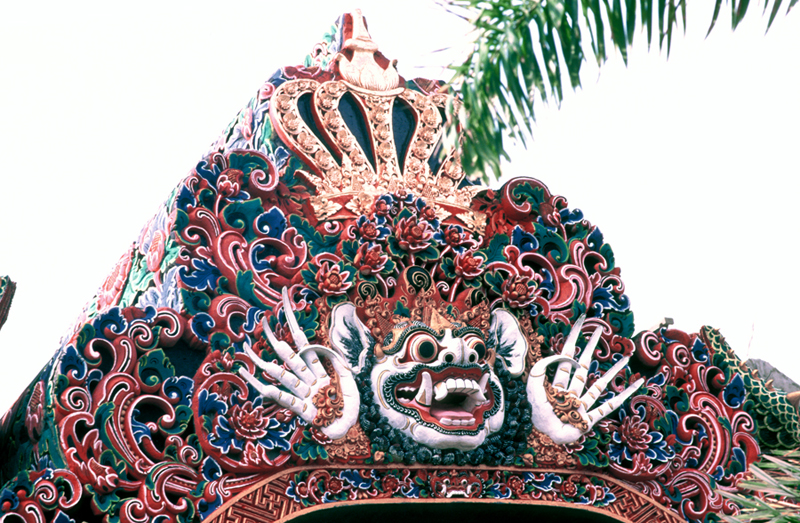
Minutes before dawn I stand at the edge of a gorge. Distant clouds of vapor from the moist Balinesian earth scroll up the rock face of Gunung Agung, an ancient scarred giant, whose heaving breath cast a crust of ash and an inlay of stone crisscrossing the countryside. What the volcano 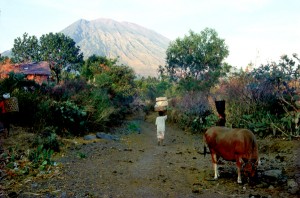 destroyed, it created decades later, in fertile rice fields, beds of basalt and, the serendipitous bonus, a scuba site unrivaled in the Lesser Sundas. The mauve-coloured mountain sleeps for now, save for a blast of amethyst light that appears on the ocean’s horizon and torches the crater’s jagged crown with gold. Sunrise reveals a wet tangle of grass and misted teakwood trees on sloping meadows and red gossamer wings of dragonflies skimming over yellow petals of Allamanda blossoms.
destroyed, it created decades later, in fertile rice fields, beds of basalt and, the serendipitous bonus, a scuba site unrivaled in the Lesser Sundas. The mauve-coloured mountain sleeps for now, save for a blast of amethyst light that appears on the ocean’s horizon and torches the crater’s jagged crown with gold. Sunrise reveals a wet tangle of grass and misted teakwood trees on sloping meadows and red gossamer wings of dragonflies skimming over yellow petals of Allamanda blossoms.
At this early hour, it’s not unusual to see women carrying supplies from the village, petite Balinese who can balance everything from drums of water to scuba tanks on their heads. Wrapped in handspun sarongs beneath yellow or white lace shirts, girdled at the waist with a wide selendang, they’re smooth featured, with café-au-lait skin and ebony hair wound at the nape of the neck. I imagine the feel of the delicate cloth, and immediately imitate their posture-perfect glide, my camera bag on its perch, while strolling down the strip of asphalt that separates thatched-roofed row houses, humming “younger than springtime am I.” Another single file of 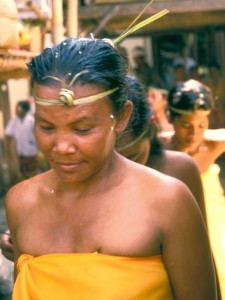 women parade past me toting baskets of fruit and produce which, I’m told, are for the commemorative rite for four villagers who died during the year. Proud to have a foreigner attend their community event, I’m invited to this joyous celebration, which marks the passing from one life to the next.
women parade past me toting baskets of fruit and produce which, I’m told, are for the commemorative rite for four villagers who died during the year. Proud to have a foreigner attend their community event, I’m invited to this joyous celebration, which marks the passing from one life to the next.
Although the US State Department classifies Bali as “Indonesia” and issues warnings accordingly, Hindu beliefs of the Balinese include tolerance and acceptance toward foreigners. Everyone is treated with an equally warm welcome and allowed to participate to some extent in their daily lives.
About 60 Balinese are assembled in the courtyard of a family member acting as host. On the main posts of the house, crisply carved vegetal forms seem to open up like diamond-shaped explosions, while opposite, atop a plain thatched wooden loft, a cornucopia of food and flowers garnish a gilded icon. More gods are worshiped in Bali than there are people. Apart from believing in a main god as well as equally important yet subordinate others, Balinese additionally have a personal one; this effigy may represent the family’s own.
The sound of a reverberating gong begins the ceremony. Men and women kneel under a broad shady 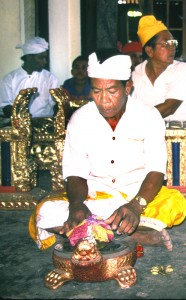 portico and elevate their joined hands to their foreheads in prayer. If the deceased fail to reach moksa, the “ultimate enlightenment,” they’ll be reincarnated over and over again until they get it right. The idea of coming back as reptiles or insects isn’t appealing; I add my wish to theirs. Prayers finished, my thoughts turn earthly as I watch handsome people of all ages perform tangang movements that symbolize the elements and honor the cosmos. Skin glistening from the white hot sky overhead, they dance around the temple with cradled bowls of water, sprigs of palm, flaming torches and fluid twists of hands. A flutist plays lonely notes on a suling. A young man strikes brass keys of his carved gansa with hammers, and the ensuing tones become haunting melodies that waft through the courtyard. The gamelan concert concludes with an incantation from the village priest, and the congregation proceeds to the rocky beach bearing the funeral bier for the next event, the cremation ceremony.
portico and elevate their joined hands to their foreheads in prayer. If the deceased fail to reach moksa, the “ultimate enlightenment,” they’ll be reincarnated over and over again until they get it right. The idea of coming back as reptiles or insects isn’t appealing; I add my wish to theirs. Prayers finished, my thoughts turn earthly as I watch handsome people of all ages perform tangang movements that symbolize the elements and honor the cosmos. Skin glistening from the white hot sky overhead, they dance around the temple with cradled bowls of water, sprigs of palm, flaming torches and fluid twists of hands. A flutist plays lonely notes on a suling. A young man strikes brass keys of his carved gansa with hammers, and the ensuing tones become haunting melodies that waft through the courtyard. The gamelan concert concludes with an incantation from the village priest, and the congregation proceeds to the rocky beach bearing the funeral bier for the next event, the cremation ceremony.
Cultured out and hungry, I leave the procession to have lunch at the Mimpi resort, where a group from Japan is preparing for a Fujichrome underwater photo contest. I bow arigato several times to the guests, saying hi! when everyone points to the sea; it’s less than 20 feet away. Bali’s shores touch the Java and Flores Seas to the north and the Indian Ocean to the south; the island and its eastern neighbor, Lombok, share a transmigration of Asian and 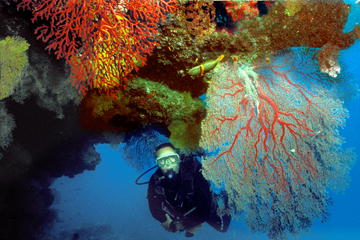 Australasian marine species through the deep Lombok Strait. A dive beckons.
Australasian marine species through the deep Lombok Strait. A dive beckons.
I blink at the shadowy form that lies in this liquid cemetery. Breathing deeply from my regulator, I swim closer, and my eyes adjust to the shape of a massive hull torn and frayed like an old sarong. The portside stern and rudder face the beach; starboard gun and boom point seaward at an awkward tilt to the bow, which elbows down the slope toward the channel’s depths. Branches of ruby-red, orange and flaxen coral, powder puffs of anemones and dangling sponges drape the skeletal remains, a surreal shroud for the silent vessel. Between the split midships a pandemonium of emperor angelfish, moorish idols, purple and orange squarespot anthias, triggerfish and groupers swim under wide umbrellas of coral-crusted metal into the hold. I survey the mangled parts like Sherlock Holmes searching for clues, while my guide, an Aussie, follows. My Dr. Watson has an I-told-you-so grin on his face, and he’s right; there are hundreds of marine species here. The ship, a torpedoed Liberty transport, was salvaged and left beached at 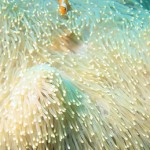 Tulamben during World War II. It slid into the sea when Agung blew in 1963, and is one of the few big wrecks in the Pacific that start as shallow as ten feet.
Tulamben during World War II. It slid into the sea when Agung blew in 1963, and is one of the few big wrecks in the Pacific that start as shallow as ten feet.
The village send-off is still going when I return. I witness the final incantations, noticing that not everyone is as solemn as before; some men are inebriated on local beer, and a few young boys have abandoned their sarongs to skinny dip alongside the extinguished burial throne. Yet all know they’re blessed by the gods. So am I. There’s a dive tonight.
It’s too early to see parrotfish tucked into membrane-coated beds, but a tobaccofish, a member of the seabass family, has already found digs, which include a bright red echinoderm for decoration. What this rocky shoal lacks in coral, it more than compensates for in the creature category. In just 20 feet of water, thumb-sized blue, white and orange nudibranchs — snails without a shell — 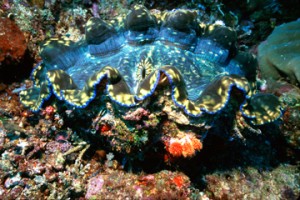 crawl along the reef rubble finding food, while a slidegill slug may go hungry tonight; there isn’t a tunicate in sight for its specialized diet. A rare find is a pair of fire gobies, whose big eyes and large mouths are disproportionate to their four-inch bodies. Bright red with a translucent lavender coat, these two swim in unison between mottled crags. I wait patiently until they’re perfectly framed in my camera and, at the propitious moment, my strobe fails. I emerge from the dive sputtering expletives, convinced that the gods ordained I should only see them and, all at once realize I could lie down on a bed of nails and sleep like a rock.
crawl along the reef rubble finding food, while a slidegill slug may go hungry tonight; there isn’t a tunicate in sight for its specialized diet. A rare find is a pair of fire gobies, whose big eyes and large mouths are disproportionate to their four-inch bodies. Bright red with a translucent lavender coat, these two swim in unison between mottled crags. I wait patiently until they’re perfectly framed in my camera and, at the propitious moment, my strobe fails. I emerge from the dive sputtering expletives, convinced that the gods ordained I should only see them and, all at once realize I could lie down on a bed of nails and sleep like a rock.
The strong Balinesian coffee kicks in the next morning; I focus on fishermen gathering something from the beach. “Rocks.” The manager points to the bungalows and surrounding houses. “They’re constructed with basalt stones from the eruption. The villagers select a certain size and shape for their homes, and construction companies haul them by the truckload to other regencies.” I marvel at the ease with which a teenager seemingly levitates over the stones with all my dive gear on her head, while I tenderly pick my way to the corner of the bay.
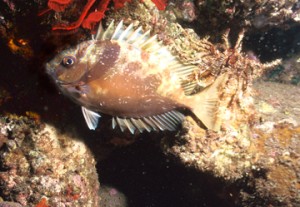 My guide and I swim out 50 yards on the western flank in the shadow of the peninsula and descend. A mild surge churns the sandy bottom, creating both poor visibility and a layer of silt over the craggy formations on this side. We follow its contour to the tip and round the point. Protruding from the nearly vertical cliff is a dazzling arrangement of barrel and rope sponges entwined in an intricate pattern of cabbage lettuce, gorgonian corals and anemones. Colorful cardinals, wrasses and damselfish that skim the facade are highlighted by sunlight penetrating crystal clear water. On the reef, coral nooks and sponge crannies house red and purple shrimp. Even the camouflaged scorpionfish are tinted shades of yellow, orange, white and black. Firmly anchored in crevasses are beach-ball size white and purple anemones, into which dash the much photographed orange and white sweetlips. Unable to resist these clowns, I finish my roll of film on them only to miss innumerable shots of juveniles hiding in staghorn coral at 30 feet.
My guide and I swim out 50 yards on the western flank in the shadow of the peninsula and descend. A mild surge churns the sandy bottom, creating both poor visibility and a layer of silt over the craggy formations on this side. We follow its contour to the tip and round the point. Protruding from the nearly vertical cliff is a dazzling arrangement of barrel and rope sponges entwined in an intricate pattern of cabbage lettuce, gorgonian corals and anemones. Colorful cardinals, wrasses and damselfish that skim the facade are highlighted by sunlight penetrating crystal clear water. On the reef, coral nooks and sponge crannies house red and purple shrimp. Even the camouflaged scorpionfish are tinted shades of yellow, orange, white and black. Firmly anchored in crevasses are beach-ball size white and purple anemones, into which dash the much photographed orange and white sweetlips. Unable to resist these clowns, I finish my roll of film on them only to miss innumerable shots of juveniles hiding in staghorn coral at 30 feet.
Preserving what remains of Bali’s natural resources is an increasing priority for the island. Products made from the endangered green turtle are 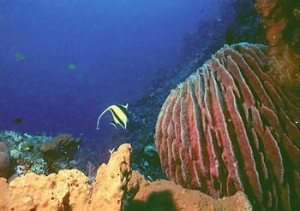 prohibited for export and efforts are underway to save the species, although some villagers in the south still sacrifice turtles for major festivals and rites of passage. Blast fishing is no longer allowed, and nearly 3000 acres of coral reef and coastal waters are protected by the Bali Barat National Park. One site, inexplicably spared from dynamite, lies off the northwest coast of Lovina in the Sendang regency. Surface waves make reaching it challenging, but once there, the flat top mound, which starts at 25 feet and slopes gently to 140, contains such a prolific distribution of hard coral (some previously found only in Hawaii and the Red Sea), that marine biologists continue to study the area. The site offers an amazing range of tropicals, including lionfish, cuttlefish and spinecheek and tomato clownfish. Grotesque tridacna clams claim the rocky bottom, their colourful, fleshy mantle and central syphon is an exaggeration only nature could invent.
prohibited for export and efforts are underway to save the species, although some villagers in the south still sacrifice turtles for major festivals and rites of passage. Blast fishing is no longer allowed, and nearly 3000 acres of coral reef and coastal waters are protected by the Bali Barat National Park. One site, inexplicably spared from dynamite, lies off the northwest coast of Lovina in the Sendang regency. Surface waves make reaching it challenging, but once there, the flat top mound, which starts at 25 feet and slopes gently to 140, contains such a prolific distribution of hard coral (some previously found only in Hawaii and the Red Sea), that marine biologists continue to study the area. The site offers an amazing range of tropicals, including lionfish, cuttlefish and spinecheek and tomato clownfish. Grotesque tridacna clams claim the rocky bottom, their colourful, fleshy mantle and central syphon is an exaggeration only nature could invent.
The scent of the sea mingles with spice. Expert hands anoint with poultices and knead in balm to release blocked energy from my body. While this ancient method of massage restores more than vitality to muscles, a visit to the Kerta Gosa Hall of Justice, the conserved remains of a 17th century palace in Klungkung, reminds all who enter of the consequences of imprudent excess. The great art of Bali is saturated with Buddhist-Hindu concepts; paintings on this ceiling are based on popular stories of the wayang puppet theatre, well established in Bali by the 10th century, and illustrate punishments meted out by demons on those whose sexual appetites transcend propriety.
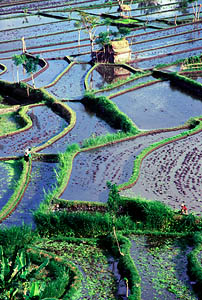 On my way to the airport, I ask the driver to stop at the top of a hill, which overlooks a shining landscape of terraced rice fields, nourished by water from Agung’s river. The afternoon heat signals a temporary respite for those who harvest this earthly nirvana; men and women cross over green tufted pools on narrow dykes and stop briefly to pray at a thatched pura, before leaving for their village. Wouldn’t my life be different living in the shadow of Gunung Agung rather than New York’s canyons. I laugh outright at this seductive thought, and follow the path that leads me away from the Island of the Gods.
On my way to the airport, I ask the driver to stop at the top of a hill, which overlooks a shining landscape of terraced rice fields, nourished by water from Agung’s river. The afternoon heat signals a temporary respite for those who harvest this earthly nirvana; men and women cross over green tufted pools on narrow dykes and stop briefly to pray at a thatched pura, before leaving for their village. Wouldn’t my life be different living in the shadow of Gunung Agung rather than New York’s canyons. I laugh outright at this seductive thought, and follow the path that leads me away from the Island of the Gods.
About Denise Mattia
A writer and photographer, Denise Mattia’s works are published nationally and internationally and include all aspects of leisure travel: art , culture, resorts, spas, food and wine and sports’ activities. She's the founder of the soon to be launched Yum-Yum-Traveler, a site devoted to reviewing restaurants in addition to her travel articles from around the world. She lives and works in Manhattan, where she was born.
- Web |
- More Posts (91)

